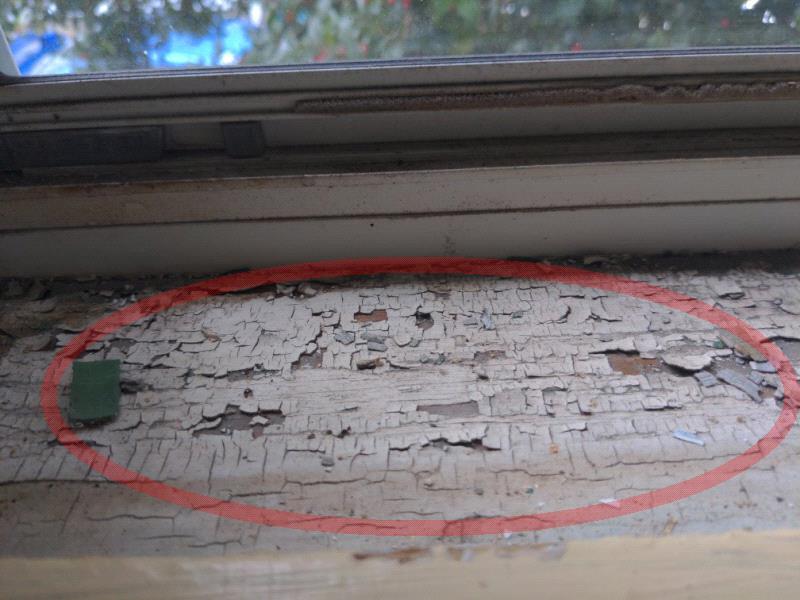As a home inspector in New Jersey, one thing that I have to be aware of when performing home inspections is the presence of lead paint an older New Jersey homes. Lead was a common component used in paint until the late 1970s. Lead paint does present significant health risks even to this day. It is advantageous for home inspectors in New Jersey to understand the basics of lead paint so we can educate our clients regarding the potential hazards. Lead paint presents a significant health risk to both the very young, old and to pregnant women.
Lead in paint was used up until the late 1970s. Lead used as a component in paint became popular and prevalent because it aided in color pigmentation of the paint. Paint manufacturers could now create vibrant colors with the help of lead. The lead in paint also increases the durability and longevity of the paint as well as it’s improving its water resistance. It is known that at least 34.6 million homes contain at least some lead paint.
Exposure to lead dust whether ingested or inhaled is toxic. Exposure to lead dust, especially in children, can lead to significant health effects such as lowered intelligence, behavioral abnormalities, learning problems, and developmental delays. In adults lead exposure can raise the blood pressure, cause kidney damage, and can create problems with fertility.
The mechanism of entry into the human body is inhalation by breathing in household dust. Household dust can contain lead particles released from old paint during the rehabilitation or remodeling process as well as sanding or scraping the paint. Areas where friction occurs such as opening and closing kitchen cabinets, doors, and windows can also lead to lead dust creation. Children can get lead exposure when they ingest lead directly inhaled from lead dust or by ingesting chipped paint.
Lead is a known toxin that can lead to brain damage. It can also cause damage to soft tissue and organs as well as cause permanent nerve damage. In high levels in the body lead exposure can lead to coma or death. Lead poisoning in the body can be challenging to detect because even in people who appear to be healthy individuals, they can have high levels of lead in their body. Symptoms usually don’t occur until dangerous amounts of lead have accumulated in the body. Some of the first symptoms of lead poisoning are nausea, joint and muscle pain, mood swings, memory problems, high blood pressure, headaches, and abdominal problems. Lead poisoning in the very young usually causes learning difficulties, irritability, weight loss, fatigue, hearing loss and memory problems.
There are several ways to identify lead paint in homes. The first way is by visual inspection. As a New Jersey home inspector, I am visually looking for signs of lead paint in homes. The telltale way is to look for signs of alligator cracking or chipping. This alligator chipping looks like small square or rectangle scales almost like the skin of an alligator where it gets its name. Often lead paint will chip in rectangular or square chips.
The second way a home inspector can identify lead paint is to carefully rub it using black gloves. Lead paint creates a chalky residue when it is rubbed.
As a home inspector, I try to educate my clients regarding the risks of lead paint. As a NJ home inspector, we do not specifically inspect for or test for the presence of lead paint However it is useful to understand what lead paint looks like that is in poor condition so it can be further evaluated if necessary. Often, we will see lead paint around and on windows. Especially inside the windowsills of older homes. This is somewhat of a problematic area because there is friction created in the opening and closing process which can create lead dust. As a New Jersey home inspector, it is up to us to educate our clients about the health hazards of having lead paint in the home as well as explaining that there are professional lead paint inspectors that can do a lead paint inspection if necessary. A professional lead paint inspector will use an XRS analyzer which is a non-destructive tool used to detect lead and paint. This equipment sees through many layers of paint and is much more precise than a do it yourself test that you can buy at the home center which only identifies the first layer of paint. This XRS technology provides immediate results and can be used as an excellent tool if the home inspection client is concerned about lead-based paint in the home, has young children, or plans to do renovations in the house where lead paint potentially can become disturbed.
If the home inspection client is going to renovate the home, it is recommended that they hire a lead safe certified contractor who is formally trained in lead safe practices meaning that there are group of techniques that have been learned to prevent lead exposure resulting from renovation and repairs in the house.
Although New Jersey home inspectors do not test lead paint directly it is up to us to educate our clients on the safety issues resulting from lead paint exposure and direct our clients to the proper resources including professional lead paint testing if warranted.

